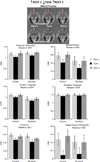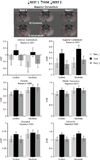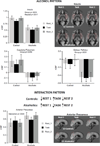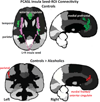A selective insular perfusion deficit contributes to compromised salience network connectivity in recovering alcoholic men
- PMID: 23587427
- PMCID: PMC3766441
- DOI: 10.1016/j.biopsych.2013.02.026
A selective insular perfusion deficit contributes to compromised salience network connectivity in recovering alcoholic men
Abstract
Background: Alcoholism can disrupt neural synchrony between nodes of intrinsic functional networks that are maximally active when resting relative to engaging in a task, the default mode network (DMN) pattern. Untested, however, are whether the DMN in alcoholics can rebound normally from the relatively depressed task state to the active resting state and whether local perfusion deficits could disrupt network synchrony when switching from conditions of rest to task to rest, thereby indicating a physiological mechanism of neural network adaptation capability.
Methods: Whole-brain, three-dimensional pulsed-continuous arterial spin labeling provided measurements of regional cerebral blood flow (CBF) in 12 alcoholics and 12 control subjects under three conditions: pretask rest, spatial working-memory task, and posttask rest.
Results: With practice, alcoholics and control subjects achieved similar task accuracy and reaction times. Both groups exhibited a high-low-high pattern of perfusion levels in DMN regions during the rest-task-rest runs and the opposite pattern in posterior and cerebellar regions known to be associated with spatial working memory. Alcoholics showed selective differences from control subjects in the rest-task-rest CBF pattern in the anterior precuneus and CBF level in the insula, a hub of the salience network. Connectivity analysis identified activation synchrony from an insula seed to salience nodes (parietal, medial frontal, anterior cingulate cortices) in control subjects only.
Conclusions: We propose that attenuated insular CBF is a mechanism underlying compromised connectivity among salience network nodes. This local perfusion deficit in alcoholics has the potential to impair ability to switch from cognitive states of interoceptive cravings to cognitive control for curbing internal urges.
Keywords: Alcohol; MRI; arterial spin labeling; brain; connectivity; perfusion; working memory.
Copyright © 2013 Society of Biological Psychiatry. Published by Elsevier Inc. All rights reserved.
Conflict of interest statement
Drs. Pfefferbaum, Chanraud, Pitel, Müller-Oehring, Rohlfing, and Sullivan report no biomedical financial interests or potential conflicts of interest..
Figures





References
-
- Nicolas JM, Catafau AM, Estruch R, Lomena FJ, Salamero M, Herranz R, et al. Regional cerebral blood Flow-SPECT in chronic alcoholism: Relation to neuropsychological testing. J Nucl Med. 1993;34:1452–1459. - PubMed
-
- Kuruoglu AC, Arikan Z, Vural G, Karatas M, Arac M, Isik E. Single photon emission computerised tomography in chronic alcoholism - antisocial personality disorder may be associated with decreased frontal perfusion. Br J Psychiatry. 1996;169:348–354. - PubMed
-
- Tutus A, Kugu N, Sofuoglu S, Nardali M, Simsek A, Karaaslan F, et al. Transient frontal hypoperfusion in Tc-99m hexamethylpropyleneamineoxime single photon emission computed tomography imaging during alcohol withdrawal. Biol Psychiatry. 1998;43:923–928. - PubMed
-
- Gansler DA, Harris GJ, Oscar-Berman M, Streeter C, Lewis RF, Ahmed I, et al. Hypoperfusion of inferior frontal brain regions in abstinent alcoholics: a pilot SPECT study. Journal of Studies on Alcoholism. 2000;61:32–37. - PubMed
-
- Caspari D, Trabert W, Heinz G, Lion N, Henkes H, Huber G. The pattern of regional cerebral blood flow during alcohol withdrawal--a single photon emission tomography study with 99mTc-HMPAO. Acta Psychiatr Scand. 1993;87:414–417. - PubMed
Publication types
MeSH terms
Grants and funding
- R37 AA010723/AA/NIAAA NIH HHS/United States
- AA017168/AA/NIAAA NIH HHS/United States
- AA017923/AA/NIAAA NIH HHS/United States
- U01 AA017923/AA/NIAAA NIH HHS/United States
- K05 AA017168/AA/NIAAA NIH HHS/United States
- U01 AA017347/AA/NIAAA NIH HHS/United States
- AA012388/AA/NIAAA NIH HHS/United States
- R01 AA017347/AA/NIAAA NIH HHS/United States
- R01 AA012388/AA/NIAAA NIH HHS/United States
- MH80729/MH/NIMH NIH HHS/United States
- AA017347/AA/NIAAA NIH HHS/United States
- R01 EB008381/EB/NIBIB NIH HHS/United States
- R01 MH080729/MH/NIMH NIH HHS/United States
- AA010723/AA/NIAAA NIH HHS/United States
- R01 AA017923/AA/NIAAA NIH HHS/United States
- EB008381/EB/NIBIB NIH HHS/United States
- R01 AA010723/AA/NIAAA NIH HHS/United States
LinkOut - more resources
Full Text Sources
Other Literature Sources
Medical

